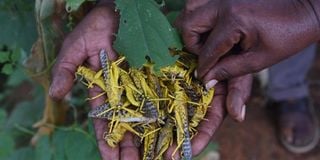Premium
Relief for Kenya in fight against desert locusts as swarms migrate

What you need to know:
- Desert locusts first entered the country on December 28, 2019 through Elwak in Mandera Country and had spread to 27 counties by March.
- In its latest report, the FAO said one of the swarms in the Northern region has crossed over to Northeast Uganda while most of the new swarms in the region, that continue to migrate northwards from Kenya, are expected to pass through South Sudan as others move to Ethiopia.
- The organisation said the swarms in Northwest Kenya are likely to migrate north to Ethiopia where they will disperse in the East and North areas to mature and breed.
The government’s war on desert locusts that continue to wreak havoc in Northern Kenya could soon be over.
This follows reports by the United Nations' Food and Agriculture Organization (FAO) that swarms will migrate northwards across South Sudan, which is experiencing rains, to breeding areas in that country.
Desert locusts first entered the country on December 28, 2019 through Elwak in Mandera Country and had spread to 27 counties by March.
The invasion has been contained in 24 counties with focus now on Marsabit and Turkana, where the government and its partners have intensified control measures.
Millions of nymphs, that are descendants of the first generation of locusts that bred in Kenya mid-February, have emerged in Samburu North and have wreaked havoc on farms and grazing fields in Barsaloi and Lojorin.
Turkana has reported about 200 hopper band sightings in pasture, with Turkana South being the hardest hit according to a previous FAO report.
THE MIGRATION
In its latest report, the FAO said one of the swarms in the Northern region has crossed over to Northeast Uganda while most of the new swarms in the region, that continue to migrate northwards from Kenya, are expected to pass through South Sudan as others move to Ethiopia.
The swarms are expected to mature and lay eggs shortly after landing in Sudan due to the good breeding and survival conditions occasioned by the rains at Kordofan and Darfur.
However, the threat of an invasion by the swarms expected to arrive in Sudan from northwest Kenya is declining because they have not yet crossed over and the rains have already hit the summer breeding areas of Sudan.
The FAO also notes that the swarms expected to arrive in Sudan are more likely to stay rather than continue to Chad where ground monitoring is ongoing.
ETHIOPIA, SOMALIA
The organisation said the swarms in Northwest Kenya are likely to migrate north to Ethiopia where they will disperse in the East and North areas to mature and breed.
This, coupled with current infestations of second generation swarms in Eastern Ethiopia and hopper bands in Eastern and Northern parts of the country, is expected to cause further increase in locust populations in that country.
The agency said new swarms reported in Somalia could migrate to summer breeding areas along the India-Pakistan border where breeding continues asking the two countries to take preparatory steps.
“New reports of desert locusts further east in Northern Somalia suggest that migration from northeast Somalia across the Indian Ocean to the areas along both sides of the Indo-Pakistan border could be imminent,” the July 13 report reads.
The agency notes that more swarms are likely to form in Northern Somalia in coming weeks.
ASIA
The arrival of the swarms in Sudan could reduce the risk of further migration to West Asia. The threat is increasing in Southwest Asia according to past FAO forecasts.
The FAO has warned that hatching and band formation will increase in Rajasthan and Gujarat parts of India as well as adjacent Nara, Cholistan and Tharparkar areas in Pakistan.
Though some swarms have been spotted in Uttar Pradesh in India, with one swarmlet reported in the Nepal area on July 12, the agency says it is likely the destructive pests will disperse or return towards Rajasthan without causing significant damage or breeding.
A week ago, the agency warned that breeding will continue in the interior of Yemen and that it may commence in areas of recent rains within the region and Saudi Arabia.
Some of the swarms could migrate from Yemen to Northern Somalia and Northeast Ethiopia.
An immature swarm has been reported in Asir Mountains on the Southwest of Saudi Arabia.





